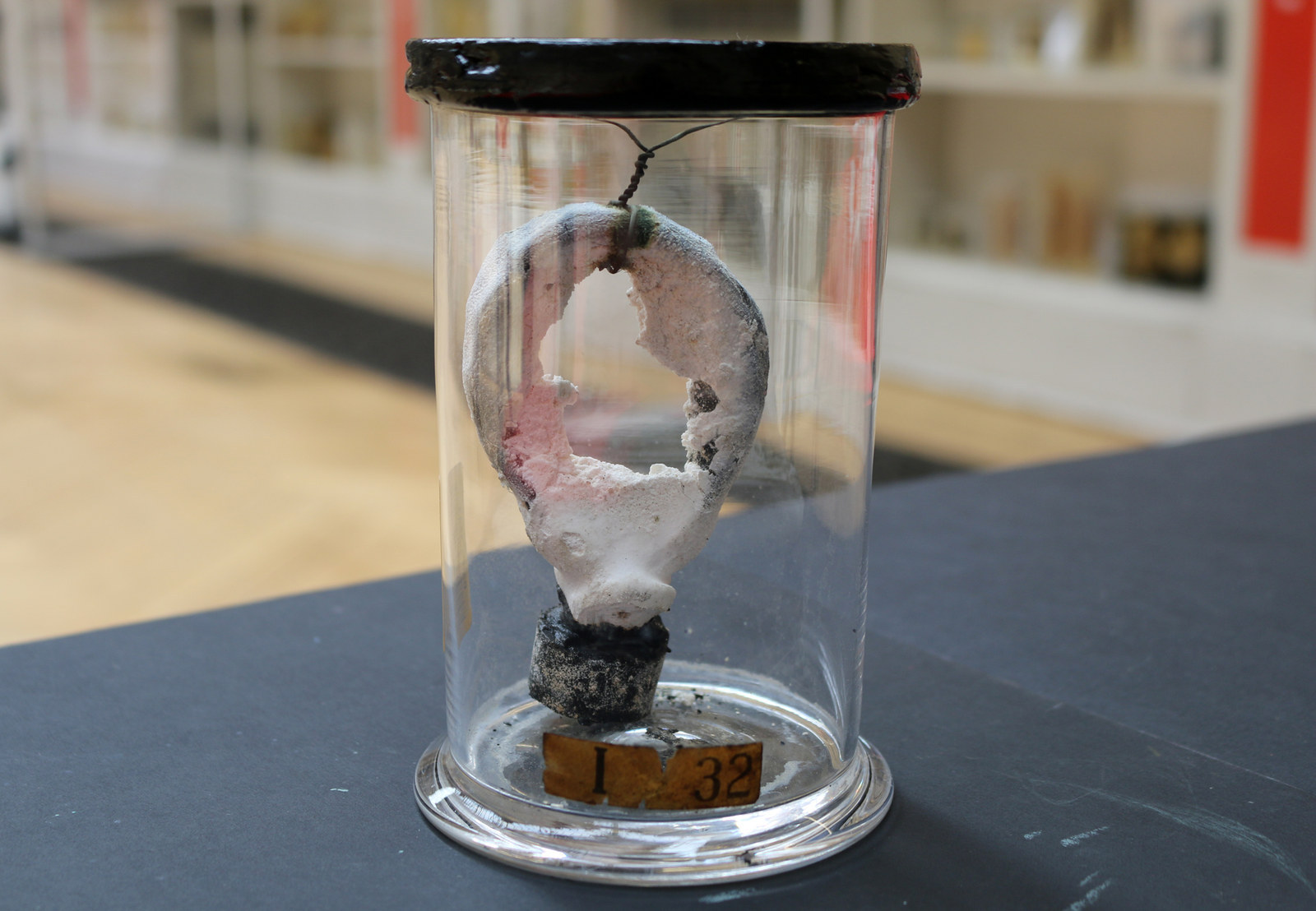
There is a special cabinet at Barts Pathology Museum in London that houses various items doctors have had to remove from patients.
For the most part, there was no medical reason to keep them, the doctors just thought it was funny. These are some of those.
Anti-aircraft shell (6.5” long by 1.3” wide)

Removed from the rectum of a 40-year-old member of the Royal Air Force, who clearly just used whatever was convenient to a member of the RAF to deal with his particular medical situation.
Says the label next to it:
“For many years he had suffered from piles which tended to prolapse. He was in the habit of replacing these with the anti-aircraft shell here shown, and on all previous occasions his attempts had been a success. On the day previous to admission he inserted the shell into his rectum, but found that after the piles had been replaced he was unable to withdraw the shell. On admission to hospital the case of the shell could just be felt 4” from the anal orifice. Removal was effected under anaesthesia after dilating the sphincter.”
Torch

A 6-inch electric torch containing neither bulb nor battery, found exactly where you think it was found.
“Removed from the rectum of an eccentric and uncouth looking man, aged 68, who stated that he had been assaulted by two drunken Irishmen who had pushed some object into his rectum. On further questioning this story was considered to be improbable.”
The torch inside the eccentric and uncouth man, probably not put there by drunken Irishmen.

Stone (1886)

A stone removed from the abdominal cavity of a sailor, aged 45, who had suffered from a
urethral stricture for years (his piss pipe was narrowed/blocked, basically).
“For the consequent urine retention, he had been in the habit of passing a glass bottle,
3” in diameter, up the rectum (and usually gained relief from it). One day retention of urine came on and, not having his bottle to hand, he instead oiled a stone and passed it into his bowel. When he began to feel inconvenience and pain, a physician was called in, and tried to remove the stone with a flat iron bent into the shape of a pair of forceps, but during this operation the intestine ruptured.
"The rectum was considerably dilated and on passing a hand into it a laceration was felt some 6” away from the anus. Only by passing in the hand as far as the elbow could the stone could be touched. Abdominal section was immediately performed and the stone removed through an incision in the abdomen.”
Here’s the take-away line from this: Only by passing in the hand as far as the elbow could the stone could be touched.

Metal pencil (1932)

A metal pencil case removed from the bladder of a man aged 46, who was “confined to a mental hospital on account of his delusions”.
“One day he complained to the medical officer that he was ‘feeling uneasy’ as he had pushed a large pencil case along the urethra into the bladder. This was regarded as a delusion on his part, until skiagrams (similar to x-rays) were carried out and illustrated the cause of his trouble. The patient made a full recovery.”
Pessary (1900)

For anyone whose vagina isn’t collapsing in on itself: that is mostly what a pessary is for – structural support for a prolapsed uterus – but it has a whole bunch of equally fun uses you can google.
This one was found in the vagina for a 75-year-old woman. It’s thickly encrusted with phosphates which is weird because there’s phosphate in urine but not in vaginas, so it probably happened due to injury and infection. We’re theorising that the fact that the pessary was in there for so long might have caused of some bad-sounding connecting opening, like a vagino/urethral fistula or something equally gross.
Toothbrush

Removed by operation from the stomach of a man who liked to clean the back of his
throat with it, and swallowed it accidentally.
Skull plug (1846)

A homemade circular plug made of cork with tape wound around it, found in the skull of an elderly women who used it to plug up her cleft palate. The plug caused the opening between the mouth and nose to gradually enlarge (she added more tape over the years to fill up the space) until it obliterated the outer walls, and the top part of her mouth was reduced to a thin outer shell with no sockets for teeth.
The view from the front:


Pin

A pin swallowed by a 10-year-old boy. Months after he swallowed it, the point emerged “through the skin, near the margin of the anus”. According to records, the boy wasn’t inconvenienced at all by swallowing a pin, with the exception of the few days prior to the extraction when he had a pin sticking out of his butt.
This is one of several pins in the museum's collection because people sure do like to put pins inside them.
Broom handle

The path of a broom handle through the body of a man who died doing what he loved: sticking broom handles up his rectum.
“He had arranged a broom handle to protrude from the top of a step-ladder which he would then sit astride. On this occasion the ladder collapsed and the man’s weight forced the broom handle up through the abdominal viscera.”
On its way through the man’s body the broom handle pierced his rectum, liver, pancreas, and finally his heart. The label reads: death by misadventure.
You can find all these specimens (bar the broom handle) in a special cabinet at Barts Pathology Museum (follow them on twitter!) reserved for things found inside people. The museum’s curator Carla Valentine runs a YouTube channel about Barts specimens that you’ll clearly love if you got this far without vomiting.
